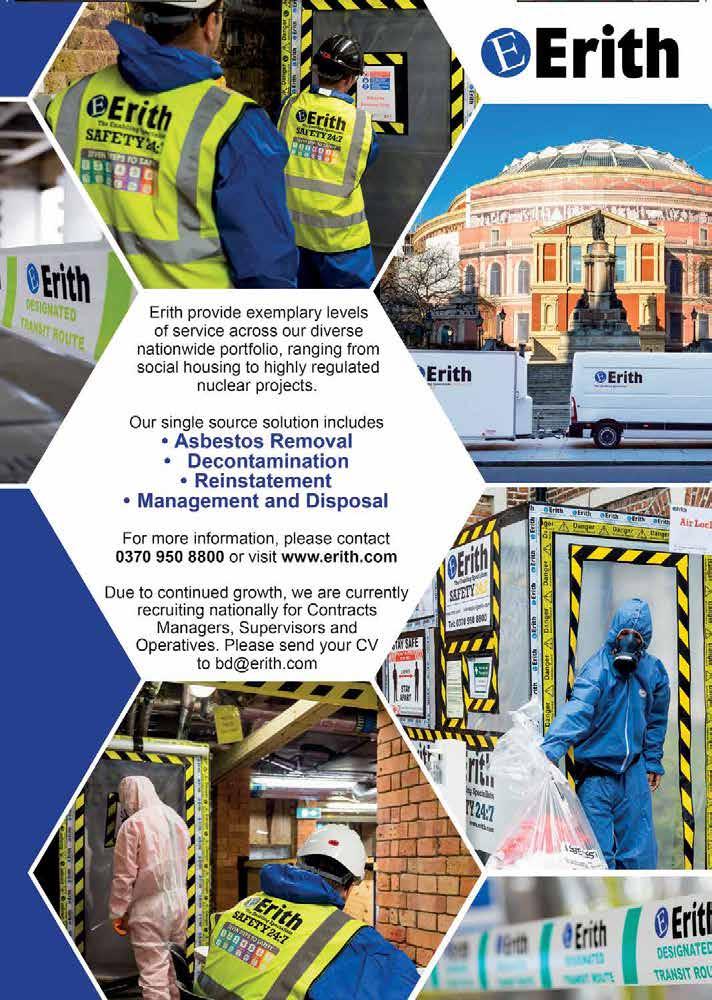
8 minute read
Risk assessments
An Overview of Risk Assessments
There is a need for a sensible and proportionate approach to risk management, in short, a balanced approach – this means ensuring that paperwork is proportionate, does not get in the way of doing the job, and it certainly does not mean risk elimination at all costs – Judith Hackitt, HSE Chair, HSG65
While your risk assessments, planning, information, training and supervision of work need to be both suitable and sufficient, it is not the case that employers must eliminate risk at all costs. The risk assessment should identify a reasonable and proportionate approach to working safely.
What are ‘hazards’ and ‘risks’?
A ‘hazard’ is described as the potential to cause harm, while a ‘risk’ is the likelihood that the hazard will cause harm. For example, two men are working at height using identical ladders, the hazard of falling off is the same for both men. However, one ladder is tied at the top and the other is not, therefore the risk of falling from the untied ladder is higher.
What the law says
The Management of Health and Safety at Work Regulations require all employers, to assess the risks to the health and safety of their employees and anyone else who may be affected by their work activities. This is to identify necessary preventive and protective measures.
Employers with five or more employees must record the significant findings of the risk assessment and then arrange to adopt the health and safety measures that follow on from this assessment.
Employers are required to provide appropriate health surveillance where the risk assessment shows it is necessary, together with such training to ensure that employees can do their job without risk. They must be given appropriate information so that they understand health and safety matters.
A health and safety risk assessment is the systematic identification of the hazards that may exist in a workplace, or in the carrying out of a task within that workplace, and the evaluation of the risks associated with those hazards.
The law states that a risk assessment must be ‘suitable and sufficient’, i.e., it should show that: w a proper check was made w you asked who might be affected w you dealt with all the obvious significant risks, considering the number of people who could be involved w the precautions are reasonable, and the remaining risk is low w you involved your workers or their representatives in the process
Risk Assessment Method
The level of detail in a risk assessment should be proportionate to the risk and appropriate to the nature of the work. Insignificant risks can usually be ignored, as can risks arising from routine activities associated with life in general, unless the work activity compounds or significantly alters those risks.
Your risk assessment should only include what you could reasonably be expected to know - you are not expected to anticipate unforeseeable risks 1. Describe each task which requires a risk assessment 2. Identify hazards in each task 3. Assess the likelihood and severity of possible resulting injury from each task 4. Identify control measures for each hazard, including necessary protective clothing and equipment 5. Identify responsibilities for carrying out the control measures 6. Identify any training and supervision issues
Everyone employed in carrying out the task should be made aware of the hazards and the control measures to be adopted.
Significant hazards and risks are defined by the HSE as those which will require the contractor to devote extra resources to their management. In other words, hazards such as trailing cables, which every contractor manages every day, do not fall within the category of significant risks.
Risks, which are significant, are those that are not trivial in nature and can create a real risk to health and safety which any reasonable person would appreciate and would take steps to guard against. What can be considered as “insignificant” will vary from site to site and activity to activity depending on specific circumstances.
The significant findings of the risk assessment need to be recorded, a simple statement as to what the risk is and what control measures are required to reduce the risk to an acceptable level and as low as reasonably practicable is all that is normally required.
Some hazards, risks and relevant controls may be common to much of the work licensed contractors do. HSE guidance acknowledges that a general risk assessment of these can be useful. In practice, such a

general risk assessment would be reflected in standard procedures (SOP) and policies. There is no requirement to replicate SOP content within a site-specific Risk Assessment / Plan of Work, although some record that existing SOP’s or policies have been assessed as suitable for controlling specific risks identified should be included.
Risk ratings and probability calculations, also known as quantitative risk assessments, normally shown as matrices where the level of hazard and risk are multiplied to give a rating are not needed. They would only be used as a guide to prioritise the implementation of control measures which is usually not relevant for licensed works.
Hierarchy of Controls
Risks should be reduced to the lowest reasonably practicable level by taking preventative measures, in order of priority.
The Hierarchy of Controls sets out an ideal order to follow when planning to reduce risk from construction activities - consider the headings in the order shown, do not simply jump to the easiest control measure to implement.
The Hierarchy of Controls, or risk hierarchy, is a system used in workplace environments to minimise or eliminate exposure to hazards. It is a widely accepted system promoted by HSE.
The Hierarchy of Controls is often represented by a triangular diagram that depicts the different controls in order of how effective they might be in controlling risk (as shown).
As you move further down the pyramid, the control measures become less effective. Once you have exhausted the ‘engineering’ options, you are then becoming much more dependent on human behaviours to reduce the risk.
The levels in the risk hierarchy of control measures are, in order of decreasing effectiveness: w Elimination - Redesign the job or substitute a substance so that the hazard is removed or eliminated. Physical removal of the hazard - this is the most effective hazard control.
For example, if employees must work high above the ground, the hazard can be eliminated by moving the piece they are working on to ground level to eliminate the need to work at height.
w Substitution – This is the second most effective hazard control and involves replacing the material or process with a less hazardous one (similar to elimination).
For example, use a small MEWP to access work at height instead of step ladders or replacing lead-based paint with titanium white. Care should be taken to ensure the alternative is safer than the original. w Engineering controls - These do not eliminate hazards, but rather isolate people from hazards.
Use work equipment or other measures to prevent falls where you cannot avoid working at height. Install or use additional machinery such as local exhaust ventilation to control risks from dust or fume. Separate the hazard from operators by methods such as enclosing or guarding dangerous items of machinery/equipment. Give priority to measures which protect collectively over individual measures. Capital costs of engineered controls tend to be higher than less effective controls in the hierarchy, however they may reduce future costs. w Administrative controls - These are changes to the way people work and are all about identifying and implementing the procedures you need to work safely.
For example: reducing the time workers are exposed to hazards (e.g., by job rotation); prohibiting use of mobile phones in hazardous areas; increasing safety signage, procedure changes, employee training and performing risk assessments.
Administrative controls do not remove hazards but intend to limit or prevent people’s exposure to the hazards. A simple example would be completing road construction at night when fewer people are driving. Another administrative control would be performing a daily check on plant e.g., forklifts, to ensure they are in good working order. w Personal protective equipment - Only after all the previous measures have been tried and found ineffective in controlling risks to a reasonably practicable level, must personal protective equipment (PPE) be used.
For example, where you cannot eliminate the risk of a fall, use work equipment or other measures to minimise the distance and consequences of a fall (should one occur). If chosen, PPE should be selected and fitted by the person who uses it. Workers must be trained in the function and limitation of each item of PPE. Personal protective equipment (PPE) includes gloves, respirators, hard hats, safety glasses, high-visibility clothing, and safety footwear.
PPE is the least effective means of controlling hazards because of the high potential for damage to render PPE ineffective. Additionally, some PPE, such as respirators, increase physiological effort to complete a task. Therefore, you may need to perform feasibility reviews and/or occupational health assessments to ensure workers can use the PPE without risking their health.
It is not necessary to implement every measure. For example, in the case of a fully boarded and guarded scaffold, workers would not be expected to wear personal fall-arrest equipment.
Most effective Hierarchy of Controls
Elimination
Physically remove the hazard
Substitution
Engineering Controls
Administration Controls
Replace the hazard
Isolate people from the hazard
Change the way people work
Least effective PPE
Protect the worker with Personal Protective Equipment


Reference: https://www.hse.gov.uk/simple-health-safety/risk/index.htm










